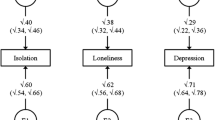Abstract
There has been increasing interest in how neighborhood context may be associated with alcohol use. This study uses finite mixture modeling to empirically identify distinct neighborhood subtypes according to patterns of clustering of multiple neighborhood characteristics and examine whether these subtypes are associated with alcohol use. Neighborhoods were 303 census block groups in the greater Seattle, WA, area where 531 adults participating in an ongoing longitudinal study were residing in 2008. Neighborhood characteristics used to identify neighborhood subtypes included concentration of poverty, racial composition, neighborhood disorganization, and availability of on-premise alcohol outlets and off-premise hard liquor stores. Finite mixture models were used to identify latent neighborhood subtypes, and regression models with cluster robust standard errors examined associations between neighborhood subtypes and individual-level typical weekly drinking and number of past-year binge drinking episodes. Five neighborhood subtypes were identified. These subtypes could be primarily characterized as (1) high socioeconomic disadvantage, (2) moderate disadvantage, (3) low disadvantage, (4) low poverty and high disorganization, and (5) high alcohol availability. Adjusted for covariates, adults living in neighborhoods characterized by high disadvantage reported the highest levels of typical drinking and binge drinking compared to those from other neighborhood subtypes. Neighborhood subtypes derived from finite mixture models may represent meaningful categories that can help identify residential areas at elevated risk for alcohol misuse.
Similar content being viewed by others
References
Diez Roux AV, Mair C. Neighborhoods and health. Ann N Y Acad Sci. 2010;1186:125–45.
Karriker-Jaffe KJ. Areas of disadvantage: a systematic review of effects of area-level socioeconomic status on substance use outcomes. Drug and alcohol review. 2011;30(1):84–95.
Kim D. Blues from the neighborhood? Neighborhood characteristics and depression. Epidemiol Rev. 2008;30:101–17.
Cerda M, Diez-Roux AV, Tchetgen ET, Gordon-Larsen P, Kiefe C. The relationship between neighborhood poverty and alcohol use: estimation by marginal structural models. Epidemiology. 2010;21(4):482–9.
Karriker-Jaffe KJ, Zemore SE, Mulia N, Jones-Webb R, Bond J, Greenfield TK. Neighborhood disadvantage and adult alcohol outcomes: differential risk by race and gender. J Stud Alcohol Drugs. 2012;73(6):865–73.
Kuipers MA, van Poppel MN, van den Brink W, Wingen M, Kunst AE. The association between neighborhood disorder, social cohesion and hazardous alcohol use: a national multilevel study. Drug Alcohol Depend. 2012;126(1–2):27–34.
Hill TD, Angel RJ. Neighborhood disorder, psychological distress, and heavy drinking. Soc Sci Med. 2005;61(5):965–75.
Brenner AB, Diez Roux AV, Barrientos-Gutierrez T, Borrell LN. Associations of alcohol availability and neighborhood socioeconomic characteristics with drinking: cross-sectional results from the Multi-Ethnic Study of Atherosclerosis (MESA). Subst Use Misuse. 2015;50(12):1606–17.
Kavanagh AM, Kelly MT, Krnjacki L, et al. Access to alcohol outlets and harmful alcohol consumption: a multi-level study in Melbourne, Australia. Addiction. 2011;106(10):1772–9.
Theall KP, Lancaster BP, Lynch S, et al. The neighborhood alcohol environment and at-risk drinking among African-Americans. Alcohol Clin Exp Res. 2011;35(5):996–1003.
Oakes JM. The (mis)estimation of neighborhood effects: causal inference for a practicable social epidemiology. Soc Sci Med. 2004;58(10):1929–52.
Messer LC, Oakes JM, Mason S. Effects of socioeconomic and racial residential segregation on preterm birth: a cautionary tale of structural confounding. Am J Epidemiol. 2010;171(6):664–73.
Keyes K, Galea S. The limits of risk factors revisited: is it time for a causal architecture approach? Epidemiology. 2017;28(1):1–5.
Collins LM, Lanza ST. Latent class and latent transition analysis: with applications in the social, behavioral, and health sciences. Hoboken, NJ: Wiley; 2010.
Adams MA, Ding D, Sallis JF, et al. Patterns of neighborhood environment attributes related to physical activity across 11 countries: a latent class analysis. Int J Behav Nutr Phy. 2013;10:34.
Krieger N, Chen JT, Waterman PD, Rehkopf DH, Subramanian SV. Race/ethnicity, gender, and monitoring socioeconomic gradients in health: a comparison of area-based socioeconomic measures—the public health disparities geocoding project. Am J Public Health. 2003;93(10):1655–71.
Stockwell T, Zhao J, Martin G, et al. Minimum alcohol prices and outlet densities in British Columbia, Canada: estimated impacts on alcohol-attributable hospital admissions. Am J Public Health. 2013;103(11):2014–20.
Bandeen-Roche K, Miglioretti DL, Zeger SL, Rathouz PJ. Latent variable regression for multiple discrete outcomes. J Am Stat Assoc. 1997;92(440):1375–86.
Rubin DB. Multiple imputation for nonresponse in surveys. Hoboken, N.J: Wiley-Interscience; 2004.
Atkins DC, Gallop RJ. Rethinking how family researchers model infrequent outcomes: a tutorial on count regression and zero-inflated models. J Fam Psychol. 2007;21(4):726–35.
R Development Core Team. R: a language and environment for statistical computing. [computer program]. Vienna, Austria: R Foundation for Statistical Computing. 2012. http://www.R-project.org. Accessed 7 January 2015.
Graham N, Arai M, Hagströmer B. multiwayvcov: multi-Way Standard Error Clustering [computer program]. R package version 1.2.3. 2016. http://CRAN.R-project.org/package=multiwayvcov. Accessed 7 January 2015.
Lumley T. mitools: tools for multiple imputation of missing data [computer program]. R package version 2.3. 2014. http://CRAN.R-project.org/package=mitools. Accessed 7 January 2015.
Gruenewald PJ. Regulating availability: how access to Alcohol affects drinking and problems in youth and adults. Alcohol Res Health. 2011;34(2):248–56.
Halonen JI, Kivimaki M, Virtanen M, et al. Proximity of off-premise alcohol outlets and heavy alcohol consumption: a cohort study. Drug Alcohol Depend. 2013;132(1–2):295–300.
Mujahid MS, Roux AVD, Morenoff JD, Raghunathan T. Assessing the measurement properties of neighborhood scales: from psychometrics to ecometrics. Am J Epidemiol. 2007;165(8):858–67.
Acknowledgements
This work was supported the National Institute on Drug Abuse [grant numbers R01DA033956, R01DA09679]. Content is solely the responsibility of the authors and does not necessarily represent the official views of the funding agency. The authors thank J. David Hawkins for his helpful comments on an earlier version of this manuscript. They also are grateful to Lawrence Frank and Jim Chapman at Urban Design 4 Health for their assistance with geocoding and creation of geospatial measures used in this study.
Author information
Authors and Affiliations
Corresponding author
Ethics declarations
This study was approved by the University of Washington Institutional Review Board.
Rights and permissions
About this article
Cite this article
Rhew, I.C., Kosterman, R. & Lee, J.O. Neighborhood Typologies Associated with Alcohol Use among Adults in Their 30s: a Finite Mixture Modeling Approach. J Urban Health 94, 542–548 (2017). https://doi.org/10.1007/s11524-017-0161-2
Published:
Issue Date:
DOI: https://doi.org/10.1007/s11524-017-0161-2




